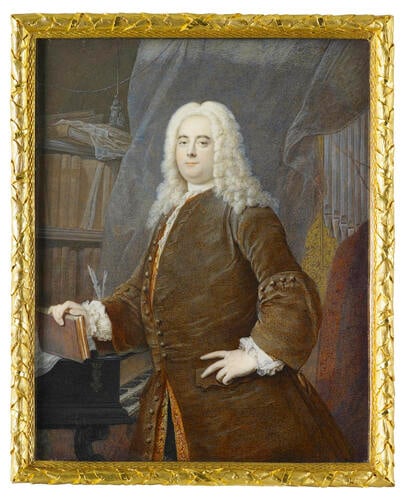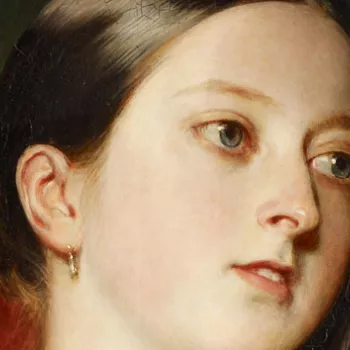George Friedrich Handel (1685-1759) c.1737
Watercolour on ivory | 16.8 x 13.2 cm (sight) (sight) | RCIN 420815
-
Georg Frideric Handel (1685-1759) was portrayed more often than any other composer of the eighteenth century. The miniature depicts him with a harpsichord and an organ, surrounded by musical scores, emphasising his skill as a performer and composer of keyboard music.
There is an oil version of the miniature (Gerald Coke Handel Collection, London) where the book Handel is holding is clearly titled Alexander's Feast, a choral work based on an ode by John Dryden which was first performed at Covent Garden in February 1736. The score was published in the following year. Louis François Roubiliac's life-size statue of Handel, commissioned for Vauxhall Pleasure Gardens (now in the Victoria and Albert Museum, London), was unveiled in 1738. This also shows Handel leaning on a pile of scores, of which Alexander's Feast is the only named volume. On 20 March of the same year a performance of Alexander's Feast was given in support of the 'Fund for Decay'd Musicians'. Handel was one of the original members of the charity concerned, the Society of Musicians, which was founded in April 1738.
Handel was born in Halle in 1685. He became Kappelmeister at the Elector's (later George I's) court in Hanover in 1709, but settled in England in 1712. He composed the 'Water Music' suite for George I in 1717 and was appointed Court Composer in 1727. His responsibilities included composing anthems for the weddings of the royal children and for Queen Caroline's funeral as well as the 'Music for the Royal Fireworks' to celebrate the Peace of Aix-la-Chapelle in 1749. He produced organ concertos as well as operas and oratorios, chief amongst which is The Messiah (1742). Handel was blind for the last seven years of his life but continued to work on his music and conduct performances until his death in 1759. Twenty-five years after Handel's death, Charles Burney, the musician and author, described him:
'The figure of Handel was large, and he was somewhat corpulent, and unwieldy in his motions; but his countenance … was full of fire and dignity; and such as inspired ideas of superiority and genius. He was impetuous, rough, and peremptory in his manners and conversation, but totally devoid of ill-nature or malevolence'. He had a 'natural propensity to wit and humour, and happy manner of relating common occurrences, in an uncommon way' which 'enabled him to throw persons and things into very ridiculous attitudes'.
The artist, Georg Andreas Wolffgang (1703-45), was born in Augsburg, the son of the artist Johann Georg Wolffgang. He travelled in Europe, visiting England and Rome in 1726 and England again in 1737-9, when it is thought that he painted this miniature. He finally settled in Gotha, Germany, where he became court painter in 1742.
Signed with initials lower left: GA / W.
Catalogue entry adapted from Masterpieces in Little: Portrait Miniatures from the Collection of Her Majesty The Queen (1992)Provenance
Possibly acquired by Prince Albert in 1860
-
Creator(s)
-
Medium and techniques
Watercolour on ivory
Measurements
16.8 x 13.2 cm (sight) (sight)
18.7 x 15.2 cm (frame, external)
Category
Object type(s)










